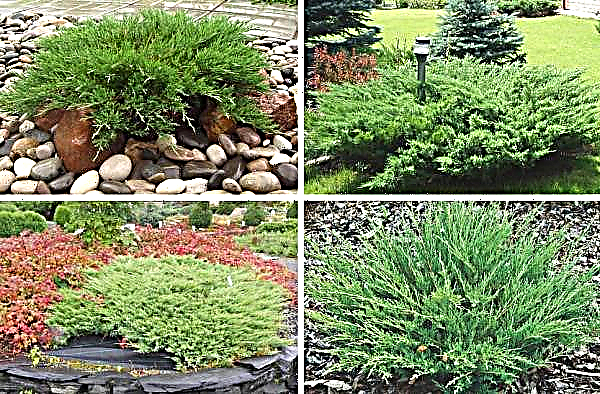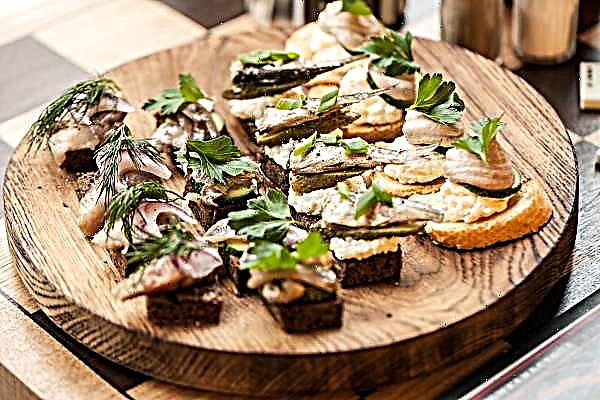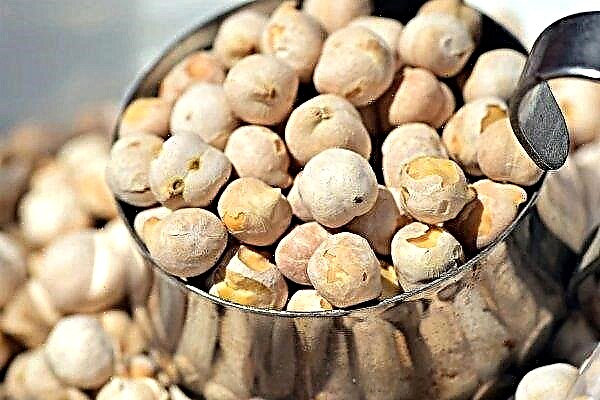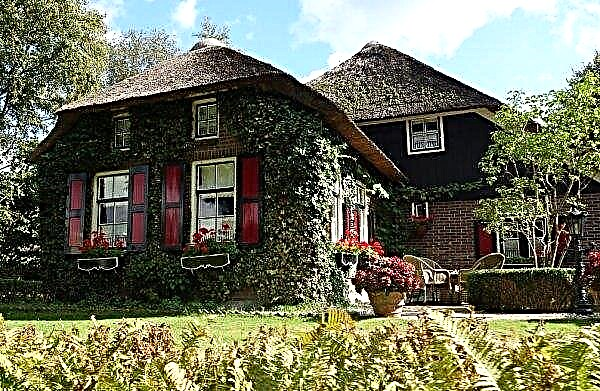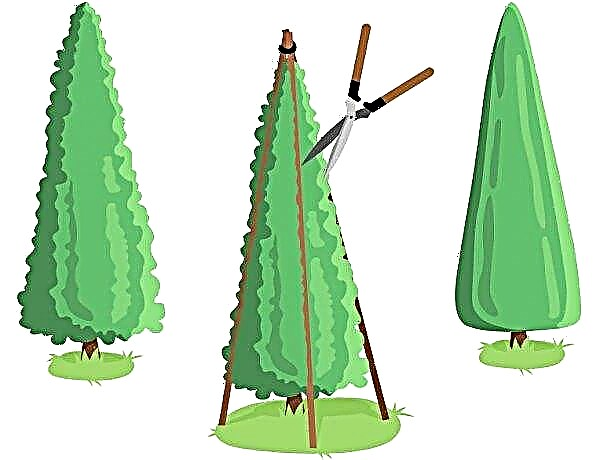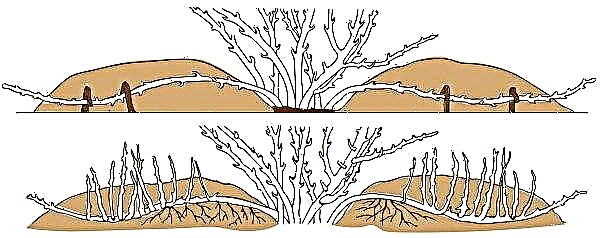Dicenter, or as it is also called "broken heart", appeared in Europe at the beginning of the XIX century. She was brought from Japan. A flower of the Poppy family (or Dymyankovye) immediately became a part of aristocratic gardens and received many names. Today, the popularity of magnificent centers is increasing. Gardeners and amateurs plant a plant and learn to care for it. The secrets of landing and care are disclosed in the article.
Features Dicentres
Of course, the memorable part of Dicentra spectabilis (or otherwise Lamprocapnos spectabilis, i.e., the magnificent heartflower) is its heart-shaped flowers, which are white, pink, red and even yellow.
Did you know? Once in Germany they made an infusion on beer of the flowering part of the described culture. It was believed that he would ensure the reciprocity of the person with whom the person drinking the drink is in love.
What does the center look like?
Description of perennial herbaceous centers:
| Leaves | ternary |
| Plant height | from 30 to 100 cm |
| Flower diameter | up to 2 cm |
| Inflorescence | racemose |
| Flowering period | May and June |
| Fruit | boxes |
| Seeds | black oblong |
 In general, this beautiful flower looks interesting and intricate.
In general, this beautiful flower looks interesting and intricate.
Flower structure
An interesting and unusual structure are the flowers of the “broken heart”, hanging on a thin handle.
Their features:
- bilateral symmetry;
- collection in inflorescence of 7-15 pieces;
- whole sepals;
- the presence of external (colored differently) and internal (white with veins) petals;
- stamens look like petals, they are so wide;
- the pistil is oblong, its stigma is bilobate;
- with the development of the fruit box, the pestle does not disappear.

Plant species
For consideration, decorative representatives of the genus that have different varieties are interesting.
The list contains 4 types:
- Gorgeous. It differs in bush size up to 1 m and flower diameter up to 25 mm. A long period blooms from late May to August inclusive. Popular varieties are Alba with white flowers and Gold Hart, whose petals are pink and the foliage is golden green.
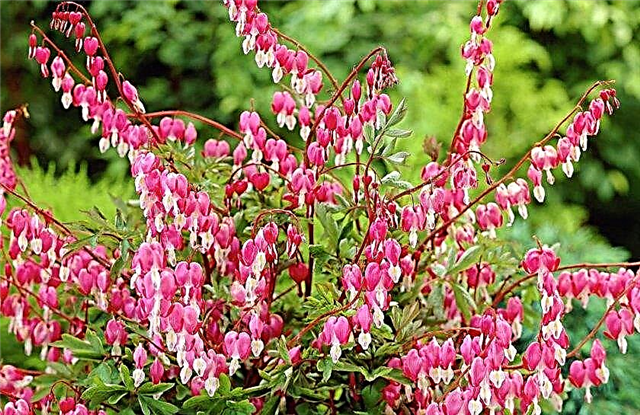
- Beautiful. Brought from California. The diameter of the buds is about 2 cm, and their shade is purple. It is represented by varietal types Aurora and Bacchanal.
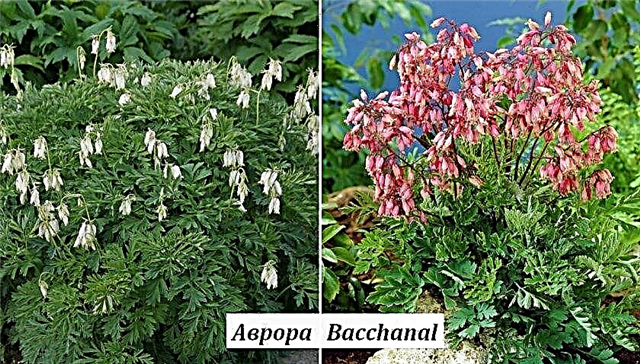
- Exclusive center. A feature of the undersized bush in the color and shape of the leaves. They are dark green and look like fern shoots. The flowering time is excellent - the process ends only in the middle of autumn.

- Climbing - an unusual plant. This is almost a liana, because the branches of the species reach 2 m. The stems can spread along the ground or stay on a support and rise upwards on it. Famous variety - Golden vine. The flowers of his very bright yellow color.

How to plant in open ground
To grow a dicenter in your garden, you should choose the right time for planting, observe the required measures, and then take good care of the plant. The tips listed below will help you learn to plant these beautiful flowers.
What time to land
There are two options for planting a “broken heart” - spring and autumn:
- In the first case, you should choose the period between the end of April and the beginning of May.
- In the second, it is better to hold an event in September.
The main condition is the availability of sufficient time for the development of the root system.
How to land
Gardeners recommend following this instruction:
- Choose a sunny or slightly shaded place, which is prepared in the spring for planting in the fall, and vice versa.
- Make sure that the soil is light, nutritious and has drainage.
- Prepare the soil in advance. To do this, you need to dig the earth and add up to 4 kg of humus per 1 m². Next - pour a solution of mineral fertilizer (for example, nitroammofoski), which is made from 20 g of the product and 10 liters of water.
- At the time for planting, you should make holes. Their diameter is equal to depth and is 40 cm. The distance between them is 1–2 m.
- Then it is supposed to create a drainage layer. Crushed stone or other similar material will do. Next, in the hole you need to pour a layer of garden soil and compost.
- Now the roots should be placed in the hole and sprinkled with the same composition.
- Water the landing site well.
Video: Landing dicentres
Care center
To ensure proper care of the perennial bush, it is necessary to carry out simple measures: to moderately water it, weed the weed grass, and loosen the soil. Spring shoots need shelter, because night temperature can destroy them.
Important! The dicenter grows well on light soils, so you can add sand to the planting holes. Adding limestone chips to the soil will have a great effect on the growth of the plant.
Watering
Irrigating the dicenter is not required abundantlybecause excessive amounts of water can cause root rot. Moderation of watering is to prevent the earth from drying out, respectively, in a dry season it is better to water the plant more often. It is also important to consider that a “broken heart” prefers soft water.
Top dressing
In the early spring after snow melts, the crop is fertilized with any nitrogen-containing fertilizer available to the gardener. Superphosphate is introduced during the flowering period. Further dressing is carried out in the fall. At this time, the center should be infused with mullein infusion.

Cultivation, mulching
All members of the genus need loose, oxygenated soil, so constant cultivation is important. Mulching favorably affects the ability of the soil to retain moisture in sufficient quantities.
This also contributes to the fact that the area around the bush will not become overgrown with weeds. By the way after making mullein in autumn, the area around the plant should be mulched with humus. Such a mulch will warm the earth in the winter and prepare a supply of nutrients for the next season.
Pinching, pinching
By mid-summer, the plant begins to fade, the leaves fade. But under the crown are young (basal) shoots. This is a new increase. If he appeared, should rejuvenate the dicenter - cut old branches. Peduncles are removed when they fade, using a secateurs. Accordingly, it is useful to cut off the remaining unnecessary escape.
You can also carry out the formation of a bush after flowering. It is necessary to pinch the stems so that a portion of them about 10 cm remains above the ground. After this procedure, more new shoots with small flowers will appear. There is another option for the development of culture: pinching the shoot after the fourth leaf to limit the number of stems. Then there will be only 3-4 branches.

Transfer
For five or more years, culture can grow in one place of your garden plot, cottage or flower bed. Then its roots grow strongly and partially die off. That is why experienced gardeners recommend replanting and dividing the bush once every 3 or 4 years. It is best to carry out such a procedure in the fall, namely: after flowering, in September. You can do this in late April or early May.
Important! For density, dicentres can plant 2-3 chopped parts of an adult bush in one landing recess.
Transplant Instructions:
- Carefully dig out the plant.
- Let the bush dry slightly.
- Then cut the roots into parts about 12 cm long, but most importantly, they should have several (3 or 4) buds.
- Slices are treated with ash.
- In the prepared wells, plant the resulting material, pour it.
Video: transplant dicentres
Care after flowering
In autumn, the remaining aboveground part of the dicenter should be cut off, leaving no more than 5 cm of the stem. Then cover with peat mulch. Covering with non-woven material is useful for protection from the cold. But it is important to avoid overly dense shelter - it leads to the fact that the plant can begin to sing.
Winter preparations
Different types and varieties of dicenters tolerate winter well, the main thing: to shelter them to protect against frost and spring night frosts. The peat mulch layer should be 5–8 cm by winter. A thicker shelter should not be done because of possible rotting. In the southern regions, do not cover the plant. It is able to survive winter frosts. Young spring shoots protected at night by spruce branches will grow better. In the afternoon they can be opened.
Seed collection
Gardeners in central Russia do not collect crop seeds. This is due to their low ability to ripen and shoot. If you live in another area or are ready to conduct an experiment, then proceed to the collection.
 In the place of flowers, plant bolls are formed. Inside them are black shiny seeds.
In the place of flowers, plant bolls are formed. Inside them are black shiny seeds.
Open the fruits and collect the seed. If it shines, has a dark shade, an oblong shape, then it is suitable for sowing. He retains germination for two years, then already loses it.
Diseases and pests
Symptoms of diseases and pests are presented in the list:
- the leaves are covered with stripes, spots or light round annular outlines - ring spotting or tobacco mosaic;
- flower stalks bend, growth slows, flowers turn yellow or green - mycoplasma disease;
- lesions along the entire length are noticeable on the plant - settlement has occurred aphidsthat you can see.
Did you know? Thanks to legends and beliefs about the plant that existed in Europe in the 19th century, there were many real weddings associated with a symbolic understanding of the shape of the flower.
Insecticides are used against insects. You can choose drugs with a narrower spectrum of action or wide. In modern stores, many different tools are presented. It is always important to follow the instructions of the selected drug.
A number of preventive measures will help prevent diseases:
- tillage, in which in a month the plant will be planted with a 5% formalin solution;
- removal of aphids (it also carries diseases);
- weeding soil, cleaning all weed grass.
 If there are slugs - they can simply be collected by setting traps (lay boards on the ground at night, turn them over during the day).
If there are slugs - they can simply be collected by setting traps (lay boards on the ground at night, turn them over during the day).
The gentle and beautiful “broken heart” is not a whimsical culture. It is easy to grow a dicenter in your area. You need to take care of the culture constantly, maintaining a good appearance and healthy development. Weeding and loosening are the main steps to take care of the dicenter. Do not overfill it with water, it is only important to maintain moderate hydration.
If you have chosen a particular variety, be sure to read the information about its features. A competent approach guarantees wonderful flowering of beautiful "hearts" on drooping shoots.





